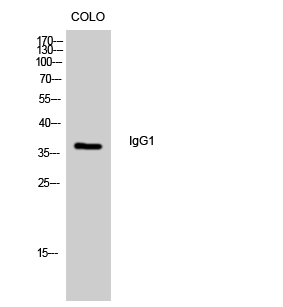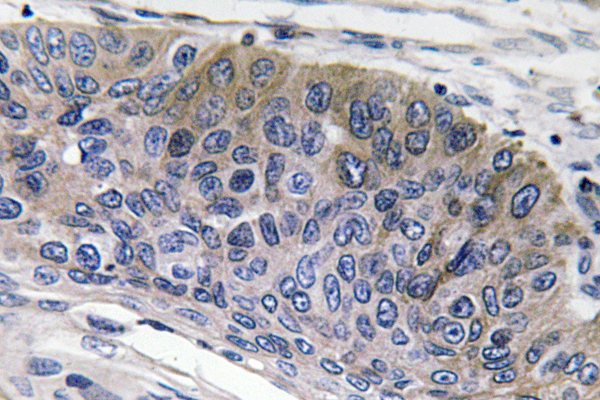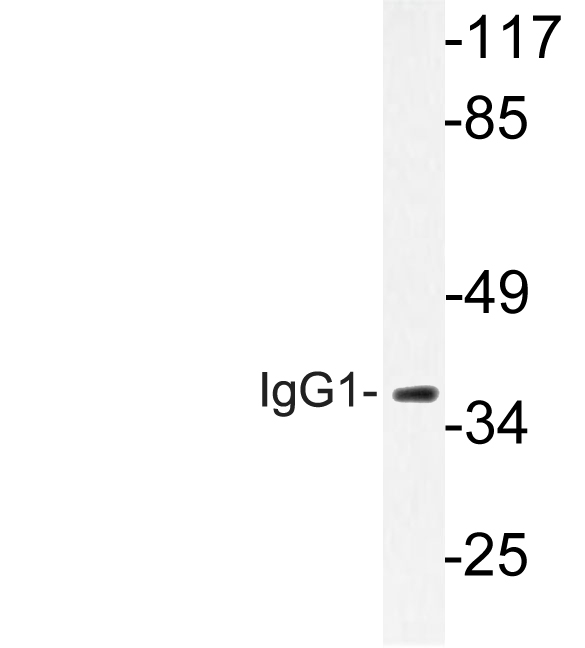IgG1 Polyclonal Antibody
- Catalog No.:YT2293
- Applications:WB;IHC;IF;ELISA
- Reactivity:Human;Mouse
- Target:
- IgG1
- Gene Name:
- IGHG1
- Protein Name:
- Ig gamma-1 chain C region
- Human Gene Id:
- 3500
- Human Swiss Prot No:
- P01857
- Mouse Swiss Prot No:
- P01868
- Immunogen:
- The antiserum was produced against synthesized peptide derived from human IgG1. AA range:196-245
- Specificity:
- IgG1 Polyclonal Antibody detects endogenous levels of IgG1 protein.
- Formulation:
- Liquid in PBS containing 50% glycerol, 0.5% BSA and 0.02% sodium azide.
- Source:
- Polyclonal, Rabbit,IgG
- Dilution:
- WB 1:500 - 1:2000. IHC 1:100 - 1:300. ELISA: 1:40000.. IF 1:50-200
- Purification:
- The antibody was affinity-purified from rabbit antiserum by affinity-chromatography using epitope-specific immunogen.
- Concentration:
- 1 mg/ml
- Storage Stability:
- -15°C to -25°C/1 year(Do not lower than -25°C)
- Other Name:
- IGHG1;Ig gamma-1 chain C region
- Observed Band(KD):
- 41kD
- Background:
- disease:Chromosomal aberrations involving IGHG1 may be a cause of multiple myeloma [MIM:254500]. Translocation t(11;14)(q13;q32) with CCND1; translocation t(4;14)(p16.3;q32.3) with FGFR3; translocation t(6;14)(p25;q32) with IRF4.,miscellaneous:Disease protein OMM may represent an allelic form or another gamma chain subclass.,miscellaneous:Disease protein WIS is lacking most of the V region and all of the CH1 region.,miscellaneous:Disease protein ZUC lack most of the V region, all of the CH1 region, and part of the hinge compared with normal gamma-3 heavy chains.,miscellaneous:EU also differs in the amidation states of residues 155, 166, 177, 195, 198, 269, and 272 and in the order of residues 268-272.,miscellaneous:KOL also differs in the amidation states of residues 198, 267 and 272.,miscellaneous:Nie also differs in the amidation states of 35, 116, 198, 269 and 272.,miscellaneous:Nie has the G1M(17) allotypic marker, 97-K, and the G1M(1) markers, 239-D and 241-L. KOL and EU sequences have the G1M(3) marker and the G1M (non-1) markers.,miscellaneous:The hinge region in gamma-3 chains is about four times as long as in other gamma chains and contains three identical 15-residue segments preceded by a similar 17-residue segment (12-28).,online information:IGHM mutation db,polymorphism:All 4 combinations of the S/G and V/G polymorphisms at positions 191 and 216 have been observed in human mu chains.,subcellular location:During differentiation, B-lymphocytes switch from expression of membrane-bound IgM to secretion of IgM.,subunit:Dimer linked by 12 disulfide bonds; it has an extra interchain disulfide bond at position 7 in addition to the 11 normally present in the hinge region.,
- Function:
- disease:Chromosomal aberrations involving IGHG1 may be a cause of multiple myeloma [MIM:254500]. Translocation t(11;14)(q13;q32) with CCND1; translocation t(4;14)(p16.3;q32.3) with FGFR3; translocation t(6;14)(p25;q32) with IRF4.,miscellaneous:Disease protein OMM may represent an allelic form or another gamma chain subclass.,miscellaneous:Disease protein WIS is lacking most of the V region and all of the CH1 region.,miscellaneous:Disease protein ZUC lack most of the V region, all of the CH1 region, and part of the hinge compared with normal gamma-3 heavy chains.,miscellaneous:EU also differs in the amidation states of residues 155, 166, 177, 195, 198, 269, and 272 and in the order of residues 268-272.,miscellaneous:KOL also differs in the amidation states of residues 198, 267 and 272.,miscellaneous:Nie also differs in the amidation states of 35, 116, 198, 269 and 272.,miscellaneous:Nie h
- Subcellular Location:
- Secreted . Cell membrane .
- Expression:
- Dermoid tumor,Esophagus tumor,Glandular pool- thyro
Single-cell RNA sequencing reveals tumor immune microenvironment in human hypopharygeal squamous cell carcinoma and lymphatic metastasis. Dapeng Lei IHC Human 1:200 Human hypopharygeal squamous cell carcinoma (HSCC) tissues
- June 19-2018
- WESTERN IMMUNOBLOTTING PROTOCOL
- June 19-2018
- IMMUNOHISTOCHEMISTRY-PARAFFIN PROTOCOL
- June 19-2018
- IMMUNOFLUORESCENCE PROTOCOL
- September 08-2020
- FLOW-CYTOMEYRT-PROTOCOL
- May 20-2022
- Cell-Based ELISA│解您多样本WB检测之困扰
- July 13-2018
- CELL-BASED-ELISA-PROTOCOL-FOR-ACETYL-PROTEIN
- July 13-2018
- CELL-BASED-ELISA-PROTOCOL-FOR-PHOSPHO-PROTEIN
- July 13-2018
- Antibody-FAQs
- Products Images

- Western Blot analysis of colo cells using IgG1 Polyclonal Antibody diluted at 1:500

- Immunohistochemistry analysis of IgG1 antibody in paraffin-embedded human lung carcinoma tissue.

- Western blot analysis of lysate from LOVO cells, using IgG1 antibody.



